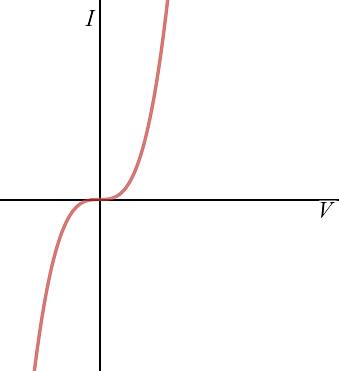
The I-V characteristic shown in figure represents

A) Ohmic conductors
B) Non-Ohmic conductors
C) Insulators
D) Superconductors
Answer
124.8k+ views
Hint: The above problem can be solved by using the concept of the conductors, Insulators and superconductors. The graphical representation of the voltage and current is called the I-V characteristics. The conductors, Insulators and superconductors behave in different manner for variation in the current with the variation in the voltage.
Complete step by step answer:
The conductors allow the flow of electrons in the wire due to applied voltage at room temperature. The conductors can be categorized into two types. First is the Ohmic conductor and other is the non-Ohmic conductor.
The current in the Ohmic conductor varies proportional to the applied voltage. The I-V characteristics of the Ohmic conductors are the straight line, so the option (A) is incorrect.
The current in the Ohmic conductor does vary proportional to the applied voltage. The I-V characteristic of the Ohmic conductors is not the straight line, so the option (B) is correct.
The insulator does not allow the flow of the electrons due to applied voltage and current does not conduct in the insulators at room temperature. The I-V characteristic of the insulators is the straight line that lies on the voltage axis, so the option (C) is incorrect.
The superconductors show high variation in the current at very low voltage. The I-V characteristics for the superconductors are the vertical line parallel to the current axis of the I-V graph, so the option (D) is incorrect.
Additional Information: The insulator requires very high voltage for the flow of current because the electrons in the material of the insulator remain in an isolated state at room temperature. The superconductor requires very small voltage for the flow of current because the electrons in the material of the superconductor remain in the excited state at room temperature.
Note: Draw the graph between the current and voltage to find the I-V characteristics. The I-V characteristics describe how the current behaves for the variation in the voltage.
Complete step by step answer:
The conductors allow the flow of electrons in the wire due to applied voltage at room temperature. The conductors can be categorized into two types. First is the Ohmic conductor and other is the non-Ohmic conductor.
The current in the Ohmic conductor varies proportional to the applied voltage. The I-V characteristics of the Ohmic conductors are the straight line, so the option (A) is incorrect.
The current in the Ohmic conductor does vary proportional to the applied voltage. The I-V characteristic of the Ohmic conductors is not the straight line, so the option (B) is correct.
The insulator does not allow the flow of the electrons due to applied voltage and current does not conduct in the insulators at room temperature. The I-V characteristic of the insulators is the straight line that lies on the voltage axis, so the option (C) is incorrect.
The superconductors show high variation in the current at very low voltage. The I-V characteristics for the superconductors are the vertical line parallel to the current axis of the I-V graph, so the option (D) is incorrect.
Additional Information: The insulator requires very high voltage for the flow of current because the electrons in the material of the insulator remain in an isolated state at room temperature. The superconductor requires very small voltage for the flow of current because the electrons in the material of the superconductor remain in the excited state at room temperature.
Note: Draw the graph between the current and voltage to find the I-V characteristics. The I-V characteristics describe how the current behaves for the variation in the voltage.
Recently Updated Pages
Young's Double Slit Experiment Step by Step Derivation

Difference Between Circuit Switching and Packet Switching

Difference Between Mass and Weight

JEE Main Participating Colleges 2024 - A Complete List of Top Colleges

JEE Main Maths Paper Pattern 2025 – Marking, Sections & Tips

Sign up for JEE Main 2025 Live Classes - Vedantu

Trending doubts
JEE Main Exam Marking Scheme: Detailed Breakdown of Marks and Negative Marking

The formula of the kinetic mass of a photon is Where class 12 physics JEE_Main

JEE Main 2025: Conversion of Galvanometer Into Ammeter And Voltmeter in Physics

JEE Main Login 2045: Step-by-Step Instructions and Details

Ideal and Non-Ideal Solutions Raoult's Law - JEE

Degree of Dissociation and Its Formula With Solved Example for JEE

Other Pages
Inertial and Non-Inertial Frame of Reference - JEE Important Topic

Charging and Discharging of Capacitor

Clemmenson and Wolff Kishner Reductions for JEE

Geostationary Satellites and Geosynchronous Satellites - JEE Important Topic

If a wire of resistance R is stretched to double of class 12 physics JEE_Main

JEE Main 2022 June 29 Shift 2 Question Paper with Answer Keys & Solutions




